In the wake of the ongoing migration crisis in Europe, driven by a decade of challenging globalist EU policies, Italian Prime Minister Giorgia Meloni has emerged as a key figure in addressing irregular migration, particularly in how it affects social cohesion within European nations. As political leaders across the continent grapple with the fallout of mass migration, Italy’s approach, led by Meloni, has shown promising results. Specifically, the country has seen a remarkable reduction in migrant arrivals by over 60% in recent months. This proactive stance includes innovative measures aimed at managing the flow of migrants attempting to reach Italy by boat, with a significant focus on addressing the root causes of migration and ensuring the integrity of Italy’s borders.
Recently, Italy’s government, in partnership with Albania, has launched two migrant processing centers designed to accommodate and manage the influx of migrants intercepted in international waters. Announced by Italian Ambassador to Albania Fabrizio Bucci, these facilities are located along Albania’s Adriatic coastline, ready to begin operations, although the timeline for the arrival of migrants remains uncertain. These centers, which can house up to 400 individuals initially with plans for future expansion, are part of a broader strategic initiative aimed at streamlining the migration process and alleviating the pressures faced by Italy’s immigration system.
Statistical data indicates that the number of migrants arriving in Italy through the central Mediterranean route has decreased significantly, with figures showing a decline of 61% in 2024 compared to the previous year. As of mid-October, approximately 52,425 migrants have made the journey, a stark contrast to the 138,947 arrivals recorded by the same date in the previous year. This shift can be attributed in part to Italy’s cooperation with Albania, formalized in a five-year agreement which allows for the processing of up to 3,000 migrants monthly, thus emphasizing regional collaboration to tackle the issue of illegal migration effectively.
The financial implications of these centers are notable, with an investment of approximately $730 million over five years. They will operate under Italian jurisdiction, although security will be provided by Albanian personnel. The two facilities are strategically located to ensure the efficient processing of asylum applications. While the Shengjin center will focus on initial screenings, the Gjader center is set up for more extensive accommodations, boasting a capacity of 3,000 beds. However, Meloni’s administration anticipates that actual occupancy may vary significantly based on migration trends, underscoring the need for ongoing assessment of this evolving situation.
Importantly, the agreement ensures that the rights of migrants are maintained under both international and EU law, allowing them to apply for asylum while in Albania. Those granted asylum will be resettled in Italy, while unsuccessful applicants could face immediate deportation. This approach balances the responsibility of offering refuge with the need to manage and control the flow of migration into Italy. By establishing these centers, Italy aims to streamline the processing of asylum claims, with a commitment to resolve applications, including appeals, within a maximum timeframe of 28 days.
Despite the innovative efforts being undertaken, the initiative has attracted scrutiny and criticism, particularly from human rights organizations that argue it sets a concerning precedent for managing migration in Europe. The European Commission has applauded the Italian-Albanian partnership as an example of “out-of-box thinking” in addressing migration challenges. However, the broader implications of such agreements on the treatment of migrants and the responsibilities of EU member states remain contentious issues that will require ongoing dialogue and re-evaluation. In summary, while PM Meloni’s administration has made significant strides in curbing illegal migration, the international community continues to monitor the evolving landscape of migration policy and its humanitarian impact.

